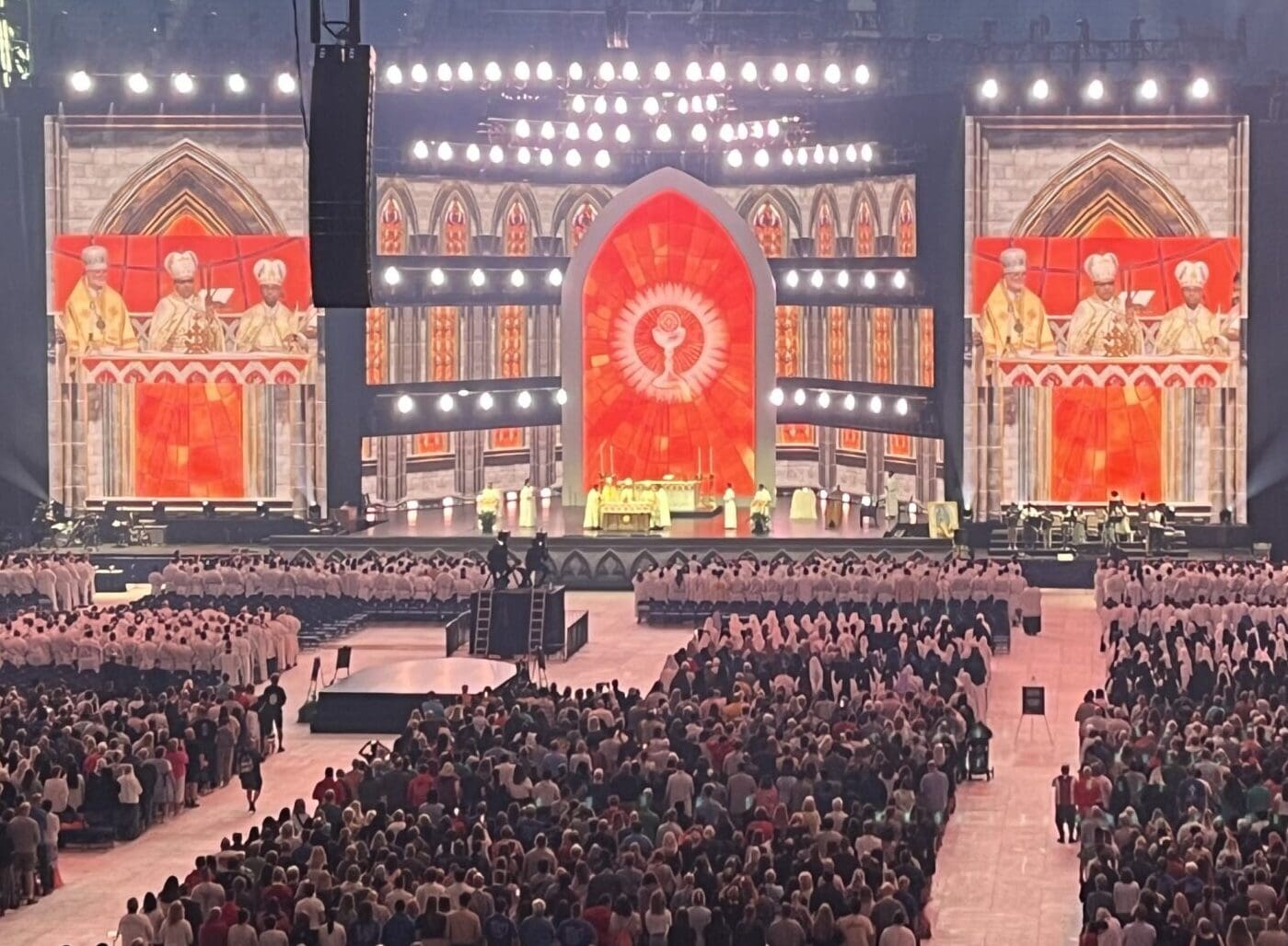
On Saturday, July 20, pilgrims at the National Eucharistic Congress were treated to a unique experience — the Syro-Malabar Rite. (Photo by Colleen Jurkiewicz)
On Saturday, July 20, Milwaukee’s delegation of pilgrims to the National Eucharistic Congress got to learn a little more about the universality of the Catholic Church and the various different rites it comprises when they attended a liturgy in the Syro-Malabar Rite.
Archbishop Andrew Cozzens, the chairman of the National Eucharistic Congress, told reporters that the inclusion of the Syro-Malabar rite in the congress’ lineup of liturgies was meant to emphasize the unity that exists in the Universal Church, even among its remarkable diversity. Congress organizers were keen for pilgrims to “experience his presence in a very different liturgy, in certain ways, but also very, very much the same,” said the archbishop.
So what is the Syro-Malabar Rite? Well, it’s the liturgy of the Syro-Malabar Catholic Church, which is the second largest of the 23 Eastern Catholic Churches that are in full communion with the Holy Father in Rome. The Syro-Malabar Church traces its origins to St. Thomas the Apostle, who brought Christianity to South India in 52 A.D.
- This Mass was one of the largest Eastern liturgies ever celebrated in the United States. Hard numbers are not available at press time, but the floor section of Lucas Oil Stadium alone held at least a thousand faithful — a number multiplied many times over by those in the stands. The Mass was presided over by Bishop Joy Alappatt and Archbishop Borys Gudziak. Bishop Alapatt is the bishop of the St. Thomas Syro-Malabar Catholic Diocese of Chicago, which was established in 2001 as the first eparchy of the Syro-Malabar Catholic Church outside of India. The St. Thomas Syro-Malabar Catholic Diocese of Chicago comprises all the Syro-Malabar faithful in the United States.
- The Syro-Malabar Rite has been described as “Indian in culture, Christian in religion and Oriental in worship.” Syriac, a dialect of Aramaic, is the liturgical language of the church, though Saturday’s liturgy was held in English.
- There are 4.6 million Syro-Malabar Catholics in the world, and that number is growing, Bishop Alapatt told the congregation at Lucas Oil Stadium. They have almost 10,000 priests and more than 30,000 nuns who serve throughout the world.
- In the Syro-Malabar Rite, the Eucharistic celebration is referred to as “Qurbãnã,” a Syrian word that means “offering.”
- Holy Qurbãnã includes the same elements of the Roman Rite, like the Service of the Word and Eucharist. The Service of the Word is celebrated from the “bĕma,” the table of the Word, meant to symbolize the earthly Jerusalem. The Eucharist is celebrated at the “madbha,” the most holy place, the sanctuary.
- Holy Qurbãnã also includes an exchange of peace, but instead of shaking hands, the faithful fold their hands and incline their heads to one another, or grasp with both hands the folded hands of the offeror.
- When receiving communion, the communicant does not say “Amen,” as in the Roman Rite — consent for the celebration is given at the beginning of the Holy Qurbãnã, and the faithful also say “Amen” after the Words of Institution.
Timothy Bailey, a parishioner of Lumen Christi Parish in Mequon, said that he had never heard of the Syro-Malabar Rite before attending Saturday’s Holy Qurbãnã.
“I’m definitely aware that there’s a Latin Rite and then there are all sorts of other rites within the Church, and I find that a beautiful part of the Church — there are so many different ways to do it,” he said, adding that he applauded the congress organizers’ decision to include different rites so prominently on the weekend’s schedule. It sets the stage for unity, he said, with other Christian and Abrahamic religions.
“That can definitely help us reach our hands out to our Protestant brothers and sisters, and our Muslim brothers and sisters and say, ‘OK, well, there’s all these different people who are Catholic … but we all have things that bind us together,’” he said. “We’re one church.”
Several pilgrims noted that there was much more standing in the Holy Qurbãnã than in a Roman Rite Mass. Standing is the standard posture during the Holy Qurbãnã,, while kneeling is considered a penitential posture.
Paul Lewandowski, a parishioner of St. Leonard Parish in Muskego, was struck by the antiquity of the rite.
“I was kind of in awe,” he said. “And the presider spoke about how much the Church in India is growing, by leaps and bounds. It’s just amazing.”
